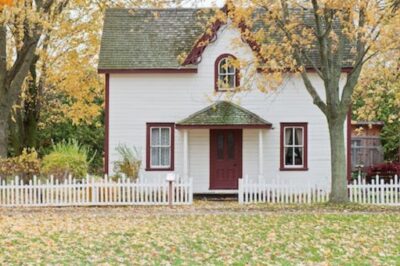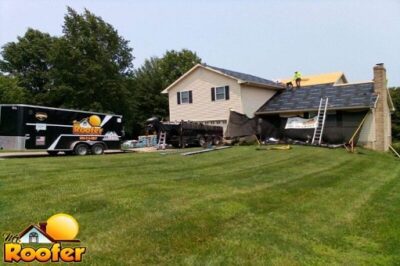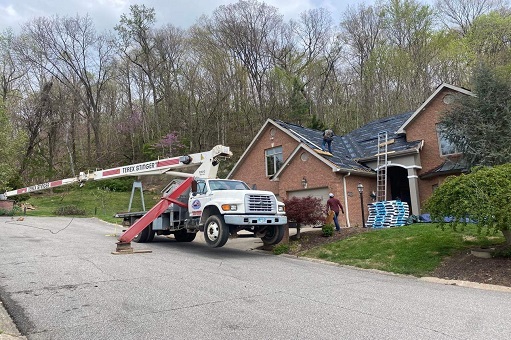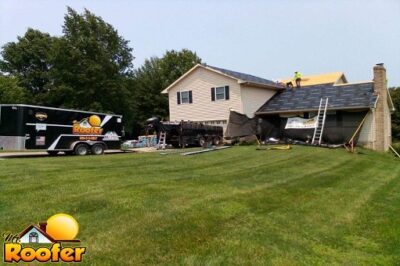Welcome to our comprehensive guide on roof leak repair—an essential resource for homeowners facing the challenges of water leaks and roof damage.
This blog’ll delve into the intricacies of detecting and addressing roof leaks, whether you’re considering a DIY approach or seeking professional assistance.
Explaining Roof Leak Repair
Roof leak repair refers to the process of identifying and fixing areas of a roof where water is infiltrating and causing leaks into the interior of a building.
It involves diagnosing the source and location of the leak, addressing the underlying issue, and implementing the necessary repairs to prevent further water penetration. The repair process can vary on the cause and extent of the leak.
Some Common Roof Leak Repairs
Replacing Damaged Shingles:
If shingles are cracked, curled, or missing, they need to be replaced to restore the roofing system’s integrity.
Repairing Flashing:
Damaged or improperly installed flashing around areas like chimneys, vents, and skylights can be repaired or replaced to prevent water entry.
Sealing Joints and Gaps:
Areas where different roof planes meet or gaps in roofing materials, can be sealed to prevent water infiltration.
Clearing Debris:
Cleaning out gutters, downspouts, and roof valleys ensures proper water drainage and prevents water accumulation.
Fixing Ventilation Issues:
Improving attic and roof space ventilation can help reduce condensation buildup, preventing moisture-related damage and leaks.
Applying Waterproof Coatings:
In some cases, applying waterproof coatings or sealants can help reinforce vulnerable areas of the roof and prevent leaks.
Replacing Underlayment:
If the underlayment beneath roofing materials is damaged or deteriorated, it may need to be replaced to maintain a watertight barrier.
Addressing Structural Issues:
In more severe cases, leaks can lead to structural damage. Repairing the damaged structure and addressing the leak source is essential.
A Step-by-step Guide to Roof Leak Repair
Here’s an essential step-by-step guide for roof leak repair:
Safety First:
Ensure you’re working in safe conditions. Use safety equipment like gloves, non-slip shoes, and fall protection.
Locate the Leak:
Inside your house, identify the area where the leak is occurring. This will help you pinpoint the area on the roof that needs repair.
Gather Materials:
Collect the necessary tools and materials, such as roofing cement, nails, tarps, roofing patches, a ladder, a putty knife, and a caulking gun.
Inspect the Roof:
Carefully climb onto the roof to inspect the suspected leak area. Look for damaged or missing shingles, cracks, or gaps.
Clear Debris:
Remove any debris or dirt from the area around the leak. This will allow you to work more effectively.
Fix Shingles:
If you find damaged shingles, carefully lift the ones around the damaged area. Apply roofing cement underneath and press them back into place. Use roofing nails to secure them if necessary.
Apply Roofing Cement:
Use a putty knife to spread roofing cement over any cracks, gaps, or damaged areas. Make sure to seal them properly.
Use Roofing Patches:
You might need roofing patches for larger holes or more significant damage. Cut a patch larger than the damaged area and apply roofing cement around the edges. Press the patch into place and cover it with more cement.
Check Flashing:
Check for damaged or improperly sealed flashing around the roof’s chimneys, vents, or other protrusions. Seal any gaps or replace the damaged flashing.
Inspect Gutters:
Ensure that gutters and downspouts are clear of debris to allow proper drainage.
Apply Caulk:
If you find gaps around vents, pipes, or other openings, use roofing caulk to seal them.
Monitor the Repair:
Monitor the repaired area during the next rainfall to ensure the leak is fully resolved. If you notice any issues, revisit the repair.
Exploring Roof Leak Repair Products
Before using any product, it’s essential to thoroughly clean and dry the area you’re repairing and follow the manufacturer’s instructions.
There are several types of roof leak repair products available in the market:
Roof Sealants:
These flexible materials can be applied to seal gaps, cracks, and joints on various roofing materials.
Roof Patches:
These are adhesive patches designed to cover small holes or punctures in the roof. They can provide a temporary fix until a more comprehensive repair can be done.
Roof Coatings:
Roof coatings are applied to the entire roof surface to provide additional protection against leaks and water damage. They come in different types, including reflective coatings that can help regulate temperature.
Flashings:
Flashing repair products are designed to fix or replace damaged flashing around chimneys, vents, and other areas where the roof meets vertical surfaces.
Roof Tapes:
Roof tapes can seal seams, joints, and small cracks. They are often used in conjunction with other repair methods.
Spray Foam Sealants:
These can be used to fill larger gaps and voids in the roofing structure, helping to prevent water infiltration.
Emergency Repair Kits:
These kits typically include various materials like patches, sealants, and tapes, which can be helpful in quickly addressing leaks in emergencies.
Roof Leak Repair DIY vs. Professional Roof Leak Repair
Deciding between DIY roof leak repair and hiring a professional depends on several factors. Here’s a comparison to help you make an informed choice:
DIY Roof Leak Repair Pros:
Cost Savings:
DIY repairs can be more budget-friendly since you won’t be paying for professional labor.
Immediate Action:
You can address minor leaks quickly without waiting for a professional to arrive.
Satisfaction of Doing It Yourself:
Successfully fixing a leak can provide a sense of accomplishment.
DIY Roof Leak Repair Cons:
Risk of Mistakes:
If you lack experience, you might inadvertently worsen the problem or miss underlying issues.
Safety Concerns:
Working on a roof can be hazardous, mostly without proper equipment and training.
Limited Expertise:
DIY repairs might not cover all potential issues, leading to temporary fixes that require professional attention later.
Voided Warranties:
Attempting repairs yourself might void warranties on roofing materials.
Professional Roof Leak Repair Pros:
Expertise:
Professionals have the skills and experience to diagnose and address various roof issues accurately.
Safety:
Trained contractors have the necessary equipment and safety measures to work on roofs safely.
Long-Term Solutions:
Professionals provide thorough repairs likely to last longer and prevent recurrence.
Warranties:
Reputable contractors often offer warranties on their work, providing peace of mind.
Comprehensive Assessment:
They can identify underlying problems and potential vulnerabilities you might miss.
Professional Roof Leak Repair Cons:
Cost:
Hiring professionals typically comes at a higher initial cost due to labor, materials, and expertise.
Scheduling:
You might need to wait for an appointment, especially during peak roofing seasons.
Dependency:
You’ll need to rely on the contractor’s schedule and expertise, which might not suit immediate needs.
Factors to Consider Before Roof Repair Leak:
Severity of the Leak:
Small, easily accessible leaks might be suitable for DIY, while significant leaks or those involving complex repairs are better left to professionals.
Skill and Experience:
Assess your abilities realistically. If you’re unfamiliar with roofing work, hiring a professional is safer.
Safety:
Roof work can be hazardous. If you’re not comfortable with heights or don’t have proper safety equipment, it’s best to hire a professional.
Long-Term Value:
Professional repairs can save you money in the long run by addressing underlying issues and preventing further damage.
Time and Convenience:
DIY might be more suitable if you need a quick fix or have time constraints. A professional is a better choice if you value a comprehensive, lasting solution.
What are the Permits required for Roof Leak Repair?
The permits required for a roof leak repair are based on your location, the extent of the repair, and local building codes.
Minor roof leak repairs might not require permits in many cases, but more extensive repairs or structural changes might. Here are some factors to consider:
Minor Repairs (Usually Do Not Require Permits):
Replacing a few damaged shingles or tiles.
Fixing minor flashing issues.
Sealing small leaks with roofing sealant.
Repairs That Might Require Permits:
Major repairs that involve significant structural changes.
Replacement of a large portion of the roof.
Changes to the roof’s slope or design.
Repairing or replacing rafters, trusses, or other structural components.
The Cost Factor: Roof Leak Repair Estimates
Several key factors can influence Roof leak repair costs, making it essential for homeowners to understand the variables that contribute to the estimates they receive. Here are some essential factors to consider:
The extent of Damage:
The severity of the roof leak and the extent of the damage it has caused will play a significant role in determining the repair cost. A minor leak that has not caused significant structural damage will likely cost less to fix compared to a major leak that has compromised the roofing system’s integrity.
Roofing Material:
The roofing material used on your home will also impact costs. Different materials require different repair techniques, and some materials are more expensive to work with than others. For example, repairing a metal roof may have different cost considerations than repairing a shingle or tile roof.
Labor and Accessibility:
The complexity of the repair and the accessibility of the damaged area can affect the cost. If the leak is in a hard-to-reach spot, it might require more labor and specialized equipment, driving up repair expenses.
Local Labor Costs:
Labor costs can vary significantly depending on your location. Areas with a higher cost of living generally have higher labor rates, impacting the overall repair estimate.
Additional Repairs:
A roof leak is sometimes just one symptom of a more significant issue. Suppose the leak is caused by underlying problems such as poor ventilation, damaged flashing, or deteriorating underlayment. In that case, these issues will also need to be addressed, potentially increasing the repair cost.
Contractor Experience:
The experience of the roofing contractor can influence the cost. Established and skilled contractors might charge more for their services but often provide higher quality work and more reliable warranties.
Emergency Repairs:
If the leak requires immediate attention due to its severity, you might be charged extra for emergency repair services.
Roof Age:
The age of your roof can also impact repair costs. Older roofs might require more extensive repairs due to wear and tear, which could lead to higher expenses.
It’s essential to request quotes from reputable roofing contractors and ensure that the estimates provided include all necessary repairs and associated costs. Remember that prioritizing quality repairs is crucial to prevent future leaks and potential damage to your home. Always choose a trusted professional who can accurately assess the situation and provide a fair estimate for the required roof leak repair.
How can I Know I Need Roof Repair?
Several signs indicate you might need roof repair:
Water Stains:
If you notice water stains on your ceilings or walls, it’s a clear sign of a possible leak. Investigate the source promptly.
Missing or Damaged Shingles:
If you see shingles that are cracked, curling, or missing altogether, they are no longer providing proper protection and need to be replaced.
Granule Loss:
Check your gutters or the ground around your house for granules from your shingles. Granule loss can indicate shingle deterioration.
Visible Light:
If you can see daylight through your roof boards in your attic, there’s likely a hole in your roof that needs repair.
Mold or Mildew Growth:
Mold and mildew thrive in damp environments. If you notice these growths in your attic or on your ceiling, it’s a sign of moisture infiltration.
Sagging Roof:
A sagging or drooping roofline can indicate structural issues caused by water damage. This requires immediate attention.
Damaged Flashing:
Flashing around chimneys, vents, and skylights can deteriorate over time, leading to leaks. If it’s damaged, repair is necessary.
Higher Energy Bills:
If your energy bills suddenly increase, it could be due to compromised insulation caused by a leak.
Interior Changes:
Peeling paint, discolored wallpaper, or warping of wood in your home’s interior can be caused by hidden roof leaks.
Age of Roof:
If your roof is nearing the end of its expected lifespan (usually around 20-25 years for asphalt shingles), it’s more susceptible to issues and might need repair or replacement.
If you notice any of these signs, it’s advisable to have a professional roofing inspection to assess the extent of the problem. Addressing roof issues early can save you from more extensive and expensive repairs.
Best Way to Save on Roof Leak Repair Costs
Here are some practical ways to save on roof leak repair costs
Prompt Action:
Address the issue as soon as you notice it. Timely repairs can prevent further damage and more expensive fixes down the line.
Multiple Quotes:
Get estimates from multiple reputable roofing contractors. This allows you to compare prices and choose the best option.
DIY for Small Repairs:
If you’re comfortable and have the necessary skills, you can tackle small repairs like sealing minor leaks using DIY kits or sealants.
Regular Maintenance:
Perform regular roof maintenance to catch issues early. Keeping your roof in good condition can prevent leaks from occurring in the first place.
Temporary Fixes:
For immediate protection, consider temporary fixes like using tarps to cover the affected area until you can get professional help.
Check Warranty:
If your roof is still under warranty, check whether the repairs are covered. This could save you significant costs.
Insurance Coverage:
If the leak resulted from a covered event, your homeowner’s insurance might cover the repair costs. Review your policy and consult your insurance provider.
Preventive Measures:
Address issues that contribute to leaks, such as clogged gutters or damaged flashing, to prevent future problems.
Consolidate Repairs:
If you have multiple minor issues, consider addressing them all at once to save on labor costs.
Open Communication:
Discuss your budget constraints with the roofing contractor. They might suggest cost-effective solutions that meet your needs.
Avoid Over-Repairing:
Address the specific problem without unnecessary extras. Focus on what’s essential to fix the leak.
Local Materials:
Opt for roofing materials that are readily available locally. This can reduce transportation costs.
Off-Peak Season:
Schedule repairs during the off-peak roofing season. Contractors might offer lower rates during less busy times.
Remember, while saving on costs is essential, prioritize quality and long-term solutions. Cutting corners might lead to recurring issues and higher expenses in the future. Always choose a reputable roofing professional to ensure the repair work is done correctly.
Additional Costs to Consider for Roof Repair Leak
When planning for a roof leak repair, it’s important to consider potential additional costs that might arise beyond the basic repair work. Here are some additional costs to keep in mind:
Roof Inspection Fees:
Before repairs can commence, a professional roof inspection might be necessary to assess the extent of the damage. Inspection fees can vary based on the complexity of the issue.
Interior Damage Repair:
If the leak has caused damage to the interior of your home, such as stained ceilings or damaged walls, you’ll need to budget for repairing or repainting these areas.
Mold Remediation:
Prolonged leaks can lead to mold growth. If mold is present, it will need to be professionally removed, which can be an additional cost.
Temporary Protection:
If you need to wait for repairs due to scheduling or weather conditions, you might need temporary protection like tarps to prevent further water infiltration.
Replacing Substrate:
The wood or other substrate beneath the roofing material may also be damaged and need roof replacement.
Roof Vent Replacement:
If the leak originates from a roof vent that’s damaged beyond repair, you might need to replace it, which can incur extra costs.
Flashing Replacement:
Damaged flashing around chimneys, vents, or skylights may need replacement, adding to the overall cost.
Gutter Cleaning/Repair:
If clogged or damaged gutters are contributing to the leak, you’ll need to address these issues to prevent future leaks.
Attic Insulation:
If the leak has compromised the insulation in your attic, you might need to replace it to ensure energy efficiency and prevent further issues.
Roof Replacement:
In some cases, if the damage is extensive and your roof is nearing the end of its lifespan, it is more cost-effective to consider a partial or full roof replacement.
It’s important to consult a professional roofer who can thoroughly assess the situation and provide a detailed estimate that includes potential additional costs. This will help you make an informed decision and budget effectively for the repair work.
Conclusion
A leaking roof is a problem that should not be ignored. Whether you choose to tackle the repair yourself with DIY solutions, or opt for professional assistance from services like Mr. Roofer, addressing roof leaks is vital to prevent further damage and maintain the integrity of your home.
With quality roof leak repair products and accurate detection equipment, you can protect your home from potential water damage and ensure its long-term stability.
How do I choose a reliable roof leak repair service?
Look for experienced, licensed, and insured professionals. Check reviews, ask for referrals, and get multiple quotes to make an informed decision.
How urgent is it to repair a leaking roof?
Addressing leaks promptly is crucial to prevent water damage, mold growth, and structural issues. Ignoring leaks can lead to more expensive repairs down the line.
Can a leaking roof vent be repaired from the inside?
In some cases, yes. Roof vent leaks might be fixed from the inside by sealing gaps around the vent. However, exterior repairs could also be necessary.
What equipment is used for roof leak detection?
Roof leak detection equipment includes infrared cameras, moisture meters, and dye testing kits. These tools help pinpoint the exact source of leaks.
How can I estimate the cost of roof leak repair?
The cost depends on factors like the extent of damage, roofing material, and labor. Getting estimates from roofing professionals will provide a clearer picture.
When should I seek professional roof leak repair services?
If the leak is significant, difficult to locate, or if you’re not comfortable working at heights, it’s best to call professionals to ensure thorough and lasting repairs.
What DIY products can I use for roof leak repair?
Roofing cement, sealant tapes, and patch kits are common DIY products. These can temporarily fix minor leaks until professional help arrives.
What are the common causes of roof leaks?
Roof leaks can result from damaged shingles, cracked flashing, clogged gutters, deteriorated sealants, or improperly installed vents.
Can I repair a leaking roof myself?
You can attempt DIY repairs for small leaks using sealants and patches. However, complex leaks might require professional assistance.
How do I know if my roof is leaking?
Look for signs like water stains on ceilings, damp spots on walls, or water dripping during rain. Mold or musty odors can also indicate a leak.






0 Comments